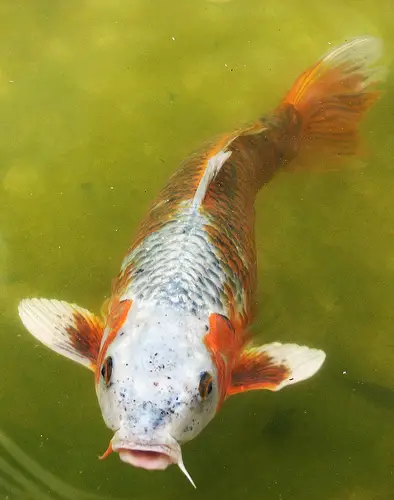A carp is a freshwater fish that is found all over the world. In some places carp have been introduced both for sport and human consumption and in others these fish are considered a pest. Carp that have been domesticated and selectively bred are popular in Japan where they originated as an ornamental fish.
Wild carp are brown or dark green in colour and are unremarkable in appearance. They have two barbells or small whiskers that hang in front of their faces. They have a low-slung mouth and eye and are somewhat plump and look like an oversized goldfish. Carp have long dorsal fins, several small and evenly spaced fins along their lower bodies, and split tales. These fish are known to grow to a remarkable size and weight. In Europe, where carp are fished for sport, they have been documented at over 36 kgs (80 lbs).
Most areas in the United States consider carp to be an invasive pest. Carp are omnivorous fish and they will consume anything and everything in their path, which often leads to waterways being muddied and aquatic plants being shredded. The consequence of this feeding pattern is that native fish species find the area no longer inhabitable and will either die off or migrate. Either result is damaging to the ecosystem. Many states actively attempt to eliminate carp in order to save native species.
Carp were originally introduced in the United States as food fish despite not being eaten in North America. The fish is popular as food in other parts of the world despite being quite bony and needing careful filleting or preservation. Depending on the environment in which the carp has been raised, it can have somewhat sweet flesh. The firm white meat of the carp is extremely sensitive to environmental factors and can change significantly based on what type of food the carp has eaten and whether or not it has been exposed to any contaminants. The majority of carp reared in the United States has accumulated levels of pollution that are unsuitable for human consumption.
In Europe, carp are considered primarily a sport fish but are also eaten. Anglers these challenging fish in lakes all over Europe, in the eastern nations in particular. In Japan, brightly coloured carp are highly sought after and are known as ‘koi’. Koi are often found in ornamental water features and lakes and some are surprisingly tame. They will often accept food offered by hand or come to the water’s surface to ‘socialize’ with their human admirers. Some koi will sell for extremely large sums.
Wild carp are brown or dark green in colour and are unremarkable in appearance. They have two barbells or small whiskers that hang in front of their faces. They have a low-slung mouth and eye and are somewhat plump and look like an oversized goldfish. Carp have long dorsal fins, several small and evenly spaced fins along their lower bodies, and split tales. These fish are known to grow to a remarkable size and weight. In Europe, where carp are fished for sport, they have been documented at over 36 kgs (80 lbs).
Most areas in the United States consider carp to be an invasive pest. Carp are omnivorous fish and they will consume anything and everything in their path, which often leads to waterways being muddied and aquatic plants being shredded. The consequence of this feeding pattern is that native fish species find the area no longer inhabitable and will either die off or migrate. Either result is damaging to the ecosystem. Many states actively attempt to eliminate carp in order to save native species.
Carp were originally introduced in the United States as food fish despite not being eaten in North America. The fish is popular as food in other parts of the world despite being quite bony and needing careful filleting or preservation. Depending on the environment in which the carp has been raised, it can have somewhat sweet flesh. The firm white meat of the carp is extremely sensitive to environmental factors and can change significantly based on what type of food the carp has eaten and whether or not it has been exposed to any contaminants. The majority of carp reared in the United States has accumulated levels of pollution that are unsuitable for human consumption.
In Europe, carp are considered primarily a sport fish but are also eaten. Anglers these challenging fish in lakes all over Europe, in the eastern nations in particular. In Japan, brightly coloured carp are highly sought after and are known as ‘koi’. Koi are often found in ornamental water features and lakes and some are surprisingly tame. They will often accept food offered by hand or come to the water’s surface to ‘socialize’ with their human admirers. Some koi will sell for extremely large sums.

